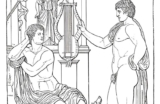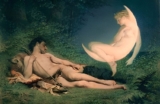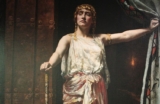Zethus was one of the twin sons of Zeus and Antiope, known for his role in the second founding of the city of Thebes. Together with his brother Amphion, ...
Polyphemus was a one-eyed giant belonging to the Cyclopes family in Greek mythology. He was a large and magnificent being, with an eye in the middle of his ...
Endymion was a Greek mortal who was so beautiful that he captured the heart of the moon goddess Selene. Apart from his relationship with Selene, Endymion is ...
Clytemnestra is an important figure in Greek mythology, known for her role in the murder of her husband, King Agamemnon and for the tragic events that ...
Echidna was a half-snake half-woman monster, known as the Mother of Monsters in Greek mythology. She was called this because she gave birth to many of the ...
In Greek mythology, Cassandra, also known as Alexandra, was a princess of Troy and a priestess of Apollo. She was a beautiful and intelligent woman who ...
In Greek mythology, when people were born, their destinies were written. The Fates, also known as Moirai, were the ones in charge of this task. The three ...
Kratos, or Cratos, is an intriguing figure in Greek mythology, with conflicting stories surrounding his origins and later life. While many younger people ...
Greek mythology is full of memorable Greek heroes, but Cadmus was the first of them. Just like Perseus and Bellerophon, Cadmus was one of the greatest ...
Thanatos, the Greek personification of Death, is an embodiment of non-violent and peaceful passing. When translated to Greek, his name literally means ...
Scylla (pronounced sa-ee-la) is one of Greek mythology’s feistiest sea monsters, known for preying near a famous narrow sea channel accompanied by the sea ...
The story of King Oedipus of Thebes was an influential part of Greek mythology, which was widely covered by many famous poets and writers. It’s a story that ...
- « Previous Page
- 1
- 2
- 3
- 4
- …
- 37
- Next Page »














